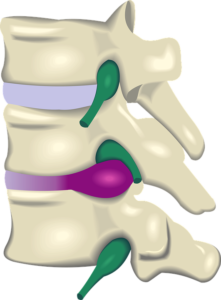MRIs – Understanding the terms – Disc Dessication and Disc Herniations 
A recent question about interpreting MRIs may help you better understand your disc problems.
“What does an MRI saying “Few upper dorsal discs show signals suggestive of disc desiccation” & “right para-central disc herniation is seen at L5-S1″ mean?”
The term disc dessication is generally referring to a degenerative process where the disc is losing hydration as it essentially develops some scar tissue.
It’s common and might be seen from repetitive stresses over a period of time or past injuries like might occur in a car accident/crash, a work injury, a sports injury, or a fall.
The Upper Back/’Shoulder’ Area
Dorsal is also known as the Thoracic Spine and is referring to the upper back area.
L5 (the lower back is the lumbar spine) is the last vertebrae in the lower back.
Below the last lumbar/lower back vertebrae is the sacrum (S1) that many people think of as the top part of the tailbone.
Understanding Discs and Disc Herniations
A very simple way to think of a disc is to look at it like a jelly donut. It has a harder fibrous crust with a softer center.
A paracentral disc herniation refers to a disc that has leaked it’s inner disc material (the jelly) backwards through the ‘crust’ towards the spinal canal.
The herniated disc is when the inner softer part of a disc pushes out through a tear in the tough outer disc.
This can occur secondary to a degenerative process over time or due to a sudden injury.
The Spinal Cord
You mentioned the L5-S1 level.
There is no spinal cord at that level.
The spinal cord generally ends at L1 to L2 level in the ‘upper’ lower back/’lower’ middle back area.
The cord continues lower than this as a group of nerves.
There are nerves in the area of L5/S1 that at times can be compressed (stretched, irritated, damaged, etc), but it will not cause a cord compression.
An MRI Is A Picture
Having said all that… there is no way to know how these findings are effecting you, if at all, by looking at an mri picture.
An exam and other functional tests by a Chiropractor in Texarkana can reveal the real problems.
Often a small visualized problem can be associated with a significant issue and at time a large visualized problem might not be causing any neurological compromise.
It varies significantly from person to person. Likewise, treatment varies depending on everything mentioned above.
If you are suffering with back pain and some disc problem with or without leg pain then it’s very likely we can help.
Contact us to set up a time to see Dr. Hagebusch to determine if Chiropractic Care can help you get better.
 Protected by Patchstack
Protected by Patchstack
Leave a Reply